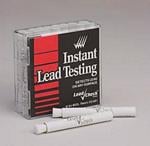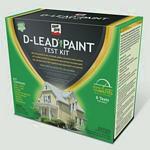Choosing Between EPA Approved Lead Test Kits
Now that they have more than one option, many renovators are now asking how to go about choosing a lead test kit. Currently there are two commercially available Lead Test Kits approved by EPA for use on RRP regulated renovations. The recognized lead test kits are offered by Hybrivet Systems, Inc. and ESCA Tech, Inc.
Hybrivet Systems, Inc. manufactures and distributes the Lead Check test kit.

ESCA Tech, Inc. manufactures and distributes the D-Lead Test kit.

The D-Lead test kit was only recently recognized for RRP use. The Lead Check Kit has been recognized since before the RRP rule came into effect on April 22, 2010.
 Given the choice, as Massachusetts and EPA authorized RRP instructor, I will definitely use the Lead Check Swabs in my training classes. I offer some reasons for this choice below. However keep in mind, if you do RRP renovations, you will likely be choosing which test lead test kit to use and why for different reasons than I would as an instructor. I hope the information below helps you make a good decision when you select a lead test kit. Please feel free to add any other comparisons or consideration for choosing a lead test kit by commenting at the end of this article.
Given the choice, as Massachusetts and EPA authorized RRP instructor, I will definitely use the Lead Check Swabs in my training classes. I offer some reasons for this choice below. However keep in mind, if you do RRP renovations, you will likely be choosing which test lead test kit to use and why for different reasons than I would as an instructor. I hope the information below helps you make a good decision when you select a lead test kit. Please feel free to add any other comparisons or consideration for choosing a lead test kit by commenting at the end of this article.
Comparison of Lead Test Kits
- In my opinion the Lead Check test kits are simpler to use. The Lead Check kits give instant results with no waiting, where as the D-Lead Test Kit instructions say the test takes 3-13 minutes.
- The Lead Check kits can be used on the surface to tested, but the D-lead kit requires the collection of samples and placement of the samples into test solution bottles.
- Lead Check swabs contain everything you need inside the swabs. You can just squeeze the kits with your fingers as instructed, shake the swab and you are ready to test. The D-Lead kits require measuring and mixing chemicals to get ready for testing.
- I believe the Lead Check kits are much safer, as they do not contain any toxic or harmful chemicals. The D-Lead test kits contain sodium hydroxide and ammonium sulfide, both of which are considered irritants to the skin and eyes and should not be ingested. Sodium sulfide smells like rotten eggs. Ammonium sulfide is also flammable.
- The Lead Check Kits can be disposed of right after use, where the D-lead kit chemicals, because they are hazardous, must first be poured into a waste disposal bag. The disposal bag is provided with the D-Lead kit and contains a waste absorbent to neutralize the harmful chemicals.
- The D-Lead kits are approved for use on drywall and plaster. The Lead Check Kit is not currently approved for use on drywall and plaster by EPA, but Hybrivet Systems, Inc. reports they should have that approval in the near future.
- The D-Lead kit has a relatively short shelf life of 12 Months unopened, but 6 months once opened. The Lead Check kits have an indefinite shelf life and therefore do not have an expiration date.
- Lead Check is available in stores everywhere and on-line. D-Lead is new to the market and therefore is not yet readily available for purchase in all markets. Their web site says it is available at The Home Depot under the name of Klean-Strip. The ESCA Tech, Inc. has a list of distributors where their product is available.
- The 8 Swab Lead Check kits are available on-line for $24.95 (about $3.12/test). When used as per the instructions, each swab can only be used once. The 6-test D-Lead kit was available at the same on-line distributer for about $28.95 (About $4.83/test) and if used as per the instructions each test can only be used once.
I hope you find this information helpful. Whether you are an RRP instructor or a renovator doing RRP work, the best way to understand the differences between lead test kits would be to read the instruction manuals for both and decide for yourself. For access to written and video instructions for both test kits see: EPA Approved Test Kit Instructions

 Looking for accurate information about the EPA RRP rule?
Looking for accurate information about the EPA RRP rule? 


